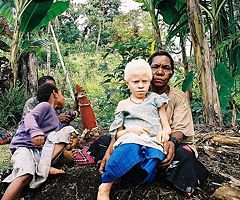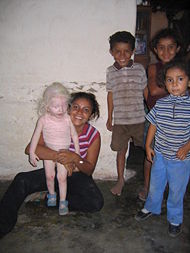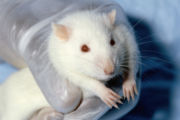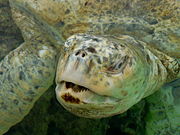Albinism
2008/9 Schools Wikipedia Selection. Related subjects: Health and medicine
| Albinism Classification and external resources |
|
| Girl from Honduras with probable OCA1a-type albinism. | |
| ICD- 10 | E 70.3 |
| ICD- 9 | 270.2 |
| OMIM | 203100 , , , , , , , , , , , , , , , , , , , , |
| DiseasesDB | 318 |
| MedlinePlus | 001479 |
| eMedicine | derm/12 |
| MeSH | D000417 |
Albinism (from Latin albus, "white"; see extended etymology) is a form of hypopigmentary congenital disorder, characterized by a partial (in hypomelanism, also known as hypomelanosis) or total (amelanism or amelanosis) lack of melanin pigment in the eyes, skin and hair (or more rarely the eyes alone). Albinism results from inheritance of recessive alleles. The condition is known to affect mammals (including humans), reptiles, amphibians, and insects. While the most common term for an organism affected by albinism is "albino" (noun and adjective), the word is sometimes used in derogatory ways towards people; the term "albinistic" (adjective) can be used to avoid the risk of being interpreted thus, as can the noun "person with albinism". Additional clinical adjectives sometimes used to refer to animals are "albinoid" and "albinic".
Types of human albinism
Albinism is hereditary; it is not an infectious disease and cannot be transmitted through contact, blood transfusions, or other vectors. The principal gene which results in albinism prevents the body from making the usual amounts of the pigment melanin. Most forms of albinism are the result of the biological inheritance of genetically recessive alleles ( genes) passed from both parents of an individual, though some rare forms are inherited from only one parent. There are other genetic mutations which are proven to be associated with albinism. All alterations, however, lead to changes in melanin production in the body.
Albinism was formerly categorized as tyrosinase-positive or -negative. In cases of tyrosinase-positive albinism, the enzyme tyrosinase is present. The melanocytes (pigment cells) are unable to produce melanin for any one of a variety of reasons that do not directly involve the tyrosinase enzyme. In tyrosinase-negative cases, either the tyrosinase enzyme is not produced or a nonfunctional version is produced. This classification has been rendered obsolete by recent research.
The chance of offspring with albinism resulting from the pairing of an organism with albinism and one without albinism is low, as discussed in more detail below. However, because organisms can be carriers of genes for albinism without exhibiting any traits, albinistic offspring can be produced by two non-albinistic parents. Albinism usually occurs with equal frequency in both genders. An exception to this is ocular albinism, because it is passed on to offspring through X-linked inheritance. Thus, males more frequently have ocular albinism.
Because organisms with albinism have skin that lacks (sufficiently or entirely) the dark pigment melanin, which helps protect the skin from ultraviolet radiation coming from the sun, they can sunburn easily from overexposure. (See human skin colour for more information). Lack of melanin in the eye also results in problems with vision, related and unrelated to photosensitivity, which are discussed further below.
Most humans and many animals with albinism appear white or very pale; the multiple types of melanin pigment are responsible for brown, black, gray, and some yellow colorations. In some animals, especially albinistic birds and reptiles, ruddy and yellow hues or other colors may be present on the entire body or in patches (as is common among pigeons), due to the presence of other pigments unaffected by albinism such as porphyrins, pteridines and psittacins, as well as carotenoid pigments derived from the diet. Some animals are white or pale due to chromatophore (pigment cell) defects, do not lack melanin production, and have normal eyes; they are referred to as leucistic. The direct opposite of albinism, an unusually high level of melanin pigmentation (and sometimes absence of other types of pigment in species that have more than one), is known as melanism, and results in an appearance darker than non-melanistic specimens from the same genepool. Albinism-like conditions may affect other pigments or pigment-production mechanisms in some animals (e.g. "whiteface", a lack of psittacins that can affect some parrot species.). Another is common in reptiles and amphibians: axanthism, in which xanthophore metabolism, instead of synthesis of melanin, is affected, resuling in reduction or absence of red and yellow pteridine pigments. Of all these conditions, only albinism and melanism affect humans.
The eyes of an animal with albinism occasionally appear red due to the underlying retinal blood vessels showing through where there is not enough pigment to cover them. In humans this is rarely the case, as a human eye is quite large and thus produces enough pigment to lend opacity to the eye, often colouring the iris pale blue. However, there are cases in which the eyes of an albinistic person appear red or purple, depending on the amount of pigment present. The albinistic are generally (but see related disorders below) as healthy as the rest of their species, with growth and development occurring as normal, and albinism by itself does not cause mortality (though the lack of pigment is an elevated risk for skin cancer and other problems.) Many animals with albinism lack their protective camouflage and are unable to conceal themselves from their predators or prey; the survival rate of animals with albinism in the wild is usually quite low. However the novelty of albino animals has occasionally led to their protection by groups such as the Albino Squirrel Preservation Society.
Intentionally-bred albinistic strains of some animal species are commonly used as model organisms in biomedical study and experimentation. Examples include the BALB/c mouse and Wistar and Sprague Dawley rat strains, while albino rabbits were historically used for Draize toxicity testing. Albino axolotls, zebrafish, medaka and frogs are other common laboratory animals. The yellow mutation in fruit flies is their version of albinism.
The incidence of albinism can be artificially increased in fish by exposing the eggs to heavy metals.
About 1 in 17,000 human beings has some type of albinism, although up to 1 in 70 is a carrier of albinism genes.
Classification
There are two main categories of albinism in humans:
- In oculocutaneous albinism (despite its Latin-derived name meaning "eye-and-skin" albinism), pigment is lacking in the eyes, skin and hair. (The equivalent mutation in non-humans also results in lack of melanin in the fur, scales or feathers.) People with oculocutaneous albinism can have anywhere from no pigment at all to almost-normal levels.
- In ocular albinism, only the eyes lack pigment. People who have ocular albinism have generally normal skin and hair colour, and many even have a normal eye appearance.
Other conditions include albinism as part of their presentation. These include Hermansky-Pudlak syndrome, Chediak-Higashi syndrome, Griscelli syndrome, Waardenburg syndrome, and Tietz syndrome. These conditions are sometimes classified with albinism.
Symptoms and conditions associated with albinism
Genetic testing can confirm albinism and what variety it is, but offers no medical benefits except in the cases of non-OCA disorders (see below) that cause albinism along with other medical problems which may be treatable. The symptoms of albinism can be treated by various methods detailed below.
Eye conditions common in albinism may include:
- Nystagmus, irregular rapid movement of the eyes back and forth, or in circular motion.
- Strabismus, eye misalignment ("crossed eyes" or "lazy eye").
- Refractive errors such as myopia or hyperopia and especially astigmatism are more likely
- Photophobia, hypersensitivity to bright light and glare.
- Foveal hypoplasia, underdevelopment of the fovea, the centre of the retina
- Optic nerve hypoplasia, underdevelopment of the optic nerve
- Abnormal decussation (crossing) of the optic nerve fibers in the optic chiasm
- Amblyopia, decrease in acuity of one or both eyes due to poor transmission to the brain, often due to other conditions such as strabismus.

Organisms with albinism usually have impaired vision due to one or more of the listed conditions. While a person with albinism may suffer from common refractive errors like nearsightedness or farsightedness, the visual problems particularly associated with albinism arise from a poorly-developed retinal pigment epithelium (RPE) due to the lack of melanin. This degenerate RPE causes foveal hypoplasia (a failure in the development of normal foveae), which results in eccentric fixation and lower visual acuity, and often a minor level of strabismus. Nystagmus is usually seen, as is photophobia or light sensitivity (see below).
The iris is a sphincter with pigmented tissue (which makes up the colour of the eyes) that contracts to limit the amount of light that can enter through the pupil and relaxes again to allow for better vision in darkness. This mechanism can be observed in humans and mammals (like in cat's eyes) and is needed because too much light is uncomfortable or even painful and decreases vision. In people with albinism, the iris does not have enough pigment to block the light, thus the decrease of pupil diameter is only partially successful in reducing the amount of light that enters the eye.. Additionally, the improper development of the RPE, which in normal eyes absorbs most of the reflected sunlight, further increases glare due to light scattering within the eye. The resulting sensitivity (photophobia) generally leads to a dislike of and discomfort in bright light, but does not prevent people with albinism enjoying the outdoors, especially when using sunglasses and/or brimmed hats.
The lack of pigment also makes the skin unusually sensitive to sunlight and thus susceptible to sunburn, so people with albinism should either avoid prolonged exposure to bright sunlight or protect their skin.
Treatment of the symptoms
Albinism is a condition that cannot be "cured," but small things can be done to improve the quality of life for those affected. Most importantly to improve vision, protect the eyes from bright lights, and avoid skin damage from sunlight. The extent and success rate of these measures depend on the type of albinism and severity of the symptoms; in particular, people with ocular albinism are likely to have normally-pigmented skin, and thus do not need to take special precautions against skin damage.
Surgical treatment
For the most part, treatment of the eye conditions consists of visual rehabilitation. Surgery is possible on the ocular muscles to decrease nystagmus, strabismus and common refractive errors like astigmatism. Strabismus surgery may improve the appearance of the eyes. Nystagmus-damping surgery can also be performed, to reduce the "shaking" of the eyes back and forth. The effectiveness of all these procedures varies greatly and depends on individual circumstances. More importantly, since surgery will not restore a normal RPE or foveae, surgery will not provide fine binocular vision. In the case of esotropia (the "crossed eyes" form of strabismus), surgery may help vision by expanding the visual field (the area that the eyes can see while looking at one point).
Sun protection
It is vital that people with albinism use sunscreen when exposed to sunlight to prevent premature skin aging or skin cancer. This poses a problem for those who cannot afford sunscreen, especially in regions with high exposure to sunlight, as in Africa.
Use of sunglasses and hats with wide brims can make the glare outside bearable. Other things that can help people with albinism are avoiding sudden changes of the lighting situation (switching the light on in complete darkness), using dimmable switches and adding tint to car windows or blinds to normal windows. Lights should be yellowish rather than blue and not point towards the usual position of a person with albinism (like their seat at a table).
Misconceptions
While some of the very rare albinism disorders that are coupled with deafness and immunodeficiency appear to be linked with inbreeding, the vast majority of sufferers of common albinism are not the product of such unions; the more usual albinism genes are widespread enough that they can easily produce albinistic offspring from parents that are not related.
A common misconception is that albinistic individuals of a species are sterile; they are in fact fully capable of reproducing. It is also thought by many that people with albinism live short life spans. This is not true in general, but may be a distorted view of a more reasonable fact that people with albinism have a higher risk of skin cancer if they do not use proper skin protection when in the sun. (Some very rare variants of albinism are lethal by adulthood or sooner, but they are so little-known by the general public that they are unlikely to have contributed to this belief.)
It has also been misunderstood that a person or other animal with albinism will become blind halfway through life; this is incorrect.


